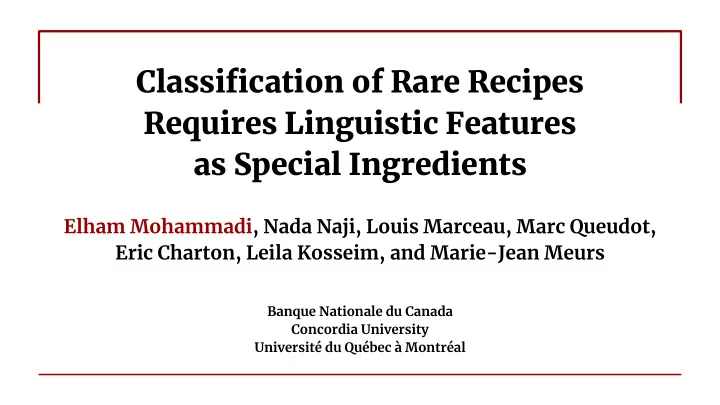

Classification of Rare Recipes Requires Linguistic Features as Special Ingredients Elham Mohammadi, Nada Naji, Louis Marceau, Marc Queudot, Eric Charton, Leila Kosseim, and Marie-Jean Meurs Banque Nationale du Canada Concordia University Université du Québec à Montréal
Contents 2 ❖ Introduction ❖ Dataset and Tasks ❖ Methodology ❖ Results and Discussion ❖ Conclusion
Contents 3 ❖ Introduction ❖ Dataset and Tasks ❖ Methodology ❖ Results and Discussion ❖ Conclusion
Introduction 4 ❖ Motivation ➢ Many real-life scenarios involve the use of highly imbalanced datasets. ➢ Extraction of discriminative features Discriminative features can be used alongside ■ distributed representations.
Introduction 5 ❖ Goal ➢ Investigating the efgectiveness of the use of discriminative features in a task with imbalanced data
Contents 6 ❖ Introduction ❖ Dataset and Tasks ❖ Methodology ❖ Results and Discussion ❖ Conclusion
Dataset and Tasks 7 ❖ DEFT (Defj Fouille de Texte) 2013 (Grouin et al., 2013) ➢ A dataset of French cooking recipes labelled as ■ Task 1: Level of diffjculty Very Easy, Easy, Fairly Diffjcult, and Diffjcult ● ■ Task 2: Meal type Starter, Main Dish, and Dessert ●
Dataset Statistics 8 Task 1 Task 2
Contents 9 ❖ Introduction ❖ Dataset and Tasks ❖ Methodology ❖ Results and Discussion ❖ Conclusion
Methodology 10 ❖ Neural sub-model Embedding layer: pretrained BERT or CamemBERT ➢ Hidden layer: CNN or GRU ➢ Pooling layer: Attention, Average, Max ➢ ❖ Linguistic sub-model Feature extractor ➢ The extraction and selection of linguistic features was done ■ according to Charton et al. (2014) Fully-connected layer ➢
Experiments 11 ❖ The joint model ❖ The independent neural-based sub-model ❖ Fine-tuned BERT and CamemBERT models
Contents 12 ❖ Introduction ❖ Dataset and Tasks ❖ Methodology ❖ Results and Discussion ❖ Conclusion
Results: Task 1 13
Results: Task 1 (Per-class F1) 14
Results: Task 2 15
Results: Task 2 (Per-class F1) 16
Discussion 17 ❖ The joint model is more efgective in task 1 compared to task 2 The linguistic features used for task 2 ➢ might not be as representative of the classes as those for task 1 ■ are signifjcantly more sparse ■ The improvement caused by the joint model is higher ➢ in case of rare classes
Contents 18 ❖ Introduction ❖ Dataset and Tasks ❖ Methodology ❖ Results and Discussion ❖ Conclusion
Conclusion 19 ❖ In both tasks, the joint models outperform their neural counterparts ❖ The improvement by the joint models is higher in Task 1 ❖ The improvement by the joint models is more signifjcant for rare classes ❖ The strength of the joint architecture is in the handling of rare classes
20 Contents ❖ Introduction ❖ Dataset and Tasks ❖ Methodology ❖ Results and Discussion ❖ Conclusion
Thank you!
Recommend
More recommend